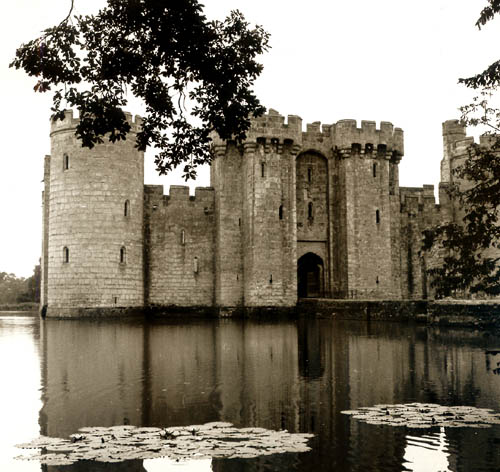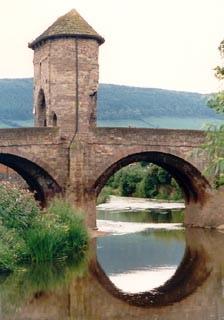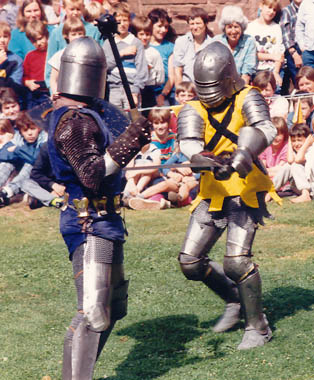Visit to England and Wales, 1987
 Photos © R.Leeuw
Photos © R.Leeuw
Visit to England and Wales, 1987 Photos © R.Leeuw Photos © R.Leeuw |
Bodiam Castle was the first of many castles and abbeys we visited this year. This castle was built in 1385 and was a serious defense work. The river Rother nearby gave good access, in those days, from plundering forces from the Sea. East Sussex is "1066 Land", William the Conqueror landed here from Normandy that year and many castles were built to safeguard their conquest (Hastings, Pevensey, Lewes; Bodiam Castle and erstmonceux soon followed). All these castles are open to the public and a great place to divulge in some rich history). At that time I was handling a serious Hasselblad 50CM medium-format camera, besides 35mm equipment. This photo was shot in B&W and tinted in Photoshop. All the photos have been scanned on a HP Scanjet 4400c. |
 Since we knew we could expect quite a bit of rain on a vacation in the UK & Wales and were travelling with a small child (not yet 3 years old), we travelled with a large tent that gave us a lot of space inside; light-weight tents available at the time of my writing this (2005) had not yet appeared on the market. This tent was not ideal for fast travelling (setting it up every night), but we did get our share of rain so it did meet its purpose.
Since we knew we could expect quite a bit of rain on a vacation in the UK & Wales and were travelling with a small child (not yet 3 years old), we travelled with a large tent that gave us a lot of space inside; light-weight tents available at the time of my writing this (2005) had not yet appeared on the market. This tent was not ideal for fast travelling (setting it up every night), but we did get our share of rain so it did meet its purpose.This campsite is at Biddenden, the first night we stayed after crossing the Channel. For food we mostly went to the pubs, but we had difficulty in adjusting to the times food was available. |
|
This is a part of Leeds Castle, a huge and impressive castle in Kent. |
 Penshurst Place is not a castle but a sublime 14th Century domestic building, one of few to survive from those days! It was built in the early-1340s by a wool merchant and financier, Sir John Pulteney. Edward VI granted this house to Sir William Sidney in 1552 and it has remained in the family ever since; Philip Sidney, Viscount De L'Isle, continues the family guardianship of this wonderful old house and beautiful garden. Most castles accepted out "Open-to-View"-tickets, but Penshurst Place did not. More can be read at www.penshurstplace.com. |
 Can you imagine King Henry VIII and Anne Boleyn strolling here, in the gardens, entertaining polite conversation! |
 We stayed with friends a few days, they lived near Abingdon and this historic town combines history to modern living. And while Tesco's was a revelation, having no such gigantic supermarkets at home, I went mainly for the history...
We stayed with friends a few days, they lived near Abingdon and this historic town combines history to modern living. And while Tesco's was a revelation, having no such gigantic supermarkets at home, I went mainly for the history...Abingdon was occupied in prehistoric times by settlers of the Bronze and Iron ages. It was a flourishing town in the Roman period, which in turn gave way to a Saxon settlement. The earliest documents tell of a hamlet called Sevekesham sited at a ford of the Thames. Hean, nephew of King Cissa was granted land for founding a Benedictine monastery called Abbandun (Hill of Ebba) at the same time as his sister Cilla founded the Nunnery of Helnestowe on or near St Helens Church, the principal church in 675AD. When Henry VIII dissolved the monasteries in 1538, Abingdon Abbey was the 6th richest in Britain. The Monday market has existed since 1556. The Michaelmas Fair (now known as the Ock Fair) was originally a 'hiring mart' for those seeking employment. Two of the main roads into Abingdon cross rivers - the Thames and the Ock - over bridges listed as ancient monuments. The bridge over the Thames is over 550 years old. Abingdon at www.oxtowns.co.uk |
 Caldicot Castle is mentioned in the Domesday Book as Caldicote. The Normans were here by 1086. The keep was probably built by Sir Humphrey de Bohun who inherited the lordship in 1221. The curtain wall was added later.
Caldicot Castle is mentioned in the Domesday Book as Caldicote. The Normans were here by 1086. The keep was probably built by Sir Humphrey de Bohun who inherited the lordship in 1221. The curtain wall was added later.It is located only 2 miles from the sea and a Roman road once known as Via Julia. In many castles, ruins or with walls intact, there are no signs of structures inside the walls, while this was a common feature (but largely built of wood so they disappeared over time). I like the structures as seen here. www.castlewales.com/caldicot |
 Most kids his age get to spend the holidays at the seaside, but he did well while his parents roamed the countryside in search of history.
Most kids his age get to spend the holidays at the seaside, but he did well while his parents roamed the countryside in search of history.We probably should have spent more time at the campground for him, eventhough the weather was cloudy with a frequent drop of rain. |
|
-Click on the image for a larger photo- Monmouth is a Welsh border market town, located where the Rivers Wye, Monnow and Trothy meet. Although used by the Romans, Monmouth's continuous history began with the Normans who used the easily defended site for a religious, military and commercial settlement. Founded soon after the Norman invasion of 1066, the town still reflects these Norman origins.  Monnow Bridge Tower is a rare 14th century stone gate tower, founded by Henry of Lancaster. Defended on the Welsh side of the River Monnow, by the Clawdd Ddu rampart and ditch and originally built with a single arched passage, it fortified the late 13th century bridge. In the 19th century, the gatehouse was pierced for pedestrian use and a hipped roof added to the upper storey. Sadly it is now the only remaining example in Britain, where the gate actually stands on a medieval river bridge.
Monnow Bridge Tower is a rare 14th century stone gate tower, founded by Henry of Lancaster. Defended on the Welsh side of the River Monnow, by the Clawdd Ddu rampart and ditch and originally built with a single arched passage, it fortified the late 13th century bridge. In the 19th century, the gatehouse was pierced for pedestrian use and a hipped roof added to the upper storey. Sadly it is now the only remaining example in Britain, where the gate actually stands on a medieval river bridge.
We had nice walk here, among pleasant shops and enjoyed the pub grub but had the scare of our life when we found our son had managed to escape our attention and we're still grateful to the shopkeepers who helped in our search and found him; it must have been one of the scariest minutes of my life! |
 Abergavenny is of course a tourist town, but pleasant nevertheless. We were on our way to the Brecon Beacons, but stopped here for a rest and have a look at the ruins of Abergavenny Castle (within whose walls the Welsh Lords of Dyfnwal were murdered..). |
 Tretower lies on the north bank of the river Usk, between Abergavenny and Brecon. We came here for a visit to the castle, but walked right into a movie set!
Tretower lies on the north bank of the river Usk, between Abergavenny and Brecon. We came here for a visit to the castle, but walked right into a movie set!People in periodic costumes walked around and this greatly enhanced the atmosphere, of course! My notes say the filming was done for "On the Dragon Trail" (P.Reed), but I have no recollection of a movie or documentary by that name. |
 There must have been sword fights in the film as well of course, and some practising was done here.
There must have been sword fights in the film as well of course, and some practising was done here.
We had only limited access to the grounds, for obvious reasons, but the costumes and decor more tha made up for it. There used to be a Norman wooden castle here, controlling the routes down the valley. The timber defences were replaced by stone probably during the 12th century. |
"Now, what am I doing here...?!" Hidden deep in a quiet valley, far up the Vale of Ewyas in the Black Mountains, lies the ruins of Llanthony Priory. Small roads with the hedgerows so typical for the English countryside made for some beautiful driving; the local pub offered excellent beer but with a history of a monastery in the area, what would you expect!
Hidden deep in a quiet valley, far up the Vale of Ewyas in the Black Mountains, lies the ruins of Llanthony Priory. Small roads with the hedgerows so typical for the English countryside made for some beautiful driving; the local pub offered excellent beer but with a history of a monastery in the area, what would you expect!Llanthony Priory was one of the earliest houses of Augustinian canons to be founded in Britain, one of only a handful in Wales. The original church, dedicated to John the Baptist and founded by William de Lacy, was destroyed in 1135; peace and renewed endowment by the de Lacy family brought canons back from Gloucester for a rebuilding phase and these remains can be seen today. The priory's church, built between 1180 and 1230, was one of the great medieval buildings of Wales. After the great rebuilding the fortunes of the abbey continued to see-saw, with most of the monks eventually retreating to Gloucester, especially after the devastation caused by Owain Glyndwr's rebellion at the beginning of the 15th century. By 1504 there were only four canons left. |
 The ruines offered some climbing, the pub had beer for the adults and a coke and fries for my son: what more do you need for a family outing?
The ruines offered some climbing, the pub had beer for the adults and a coke and fries for my son: what more do you need for a family outing?We tried to translate the history of the castles and ruins to our son into tales of sieges, fights by heroic knights, treachery and lost treasures... with varying degrees of success. We also introduced him to this horse, but he doesn't seem to be impressed (nor seems the horse to be for that matter!). |
 A visit to Goodrich Castle coincided with a Medieval Tournament held over the weekend; the tournament offered displays of archery, falconry, dance and of course sword fights! A lot of fun for both adults and kids. |
 All costumes were very detailed and these "high born ladies" seem to share the local gossip: what women did then they do now...
All costumes were very detailed and these "high born ladies" seem to share the local gossip: what women did then they do now...The Plantagenet Society performed all this and an excellent job it was, we enjoyed it tremendously! |
 Some serious sword fighting was displayed, the knights fully clad in armour and the audience was much entertained!
Some serious sword fighting was displayed, the knights fully clad in armour and the audience was much entertained! |
 There are of course things to do for kids and we enjoyed a trainride on the Brecon Mountain Railway; this was at the Merthyr Tydfil station.
The British like to seriously play with steam trains and we always enjoy an opportunity to share that enthusiasm.
There are of course things to do for kids and we enjoyed a trainride on the Brecon Mountain Railway; this was at the Merthyr Tydfil station.
The British like to seriously play with steam trains and we always enjoy an opportunity to share that enthusiasm.
|
One final castle before we go... Candleston Castle was right around around the corner of our campground, there were large dunes to fall down from and another castle -Ogmore- nearby.... The name Candleston is probably derived from the de Cantelupe family (many Anglo-Norman settlements have a name derived from the sttler plus -ton added to it: ton meaning house or farm) who built a fortified manor house here in the later 14th century. The lands of the manor later became covered with dunes and thus valueless, but the building remained occupied until the 19th century. Candleston Castle at www.castlewales.com During 19 days we had driven 2850kms and visited 21 castles and 5 churches/ruines. All this had been a bit much for our son: days after we returned home and we walked to my car to go somewhere he asked "Daddy, we're not going to visit any castles today are we?" Maybe we should consider doing things a little different next time and thus we learned the lesson all parents learn from their kids: to adjust! |
|
External links: www.castlewales.com www.castles-of-britain.com
|
|